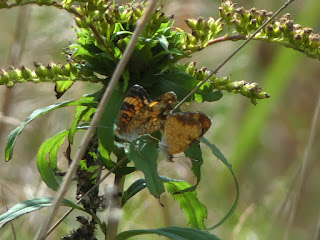Mating Pearl Crescents
On the same trip to Fairview Farm when I met the Ruby-throated Hummingbird and the Snowberry Clearwing Moth, I also met more common fauna. One interesting encounter was either 1 or 2 pairs of mating Pearl Crescent butterflies. (By my standards, this was a fairly successful outing.)
When butterflies/moths (and some other insects) mate, they face away from each other with the ends of their abdomens (temporarily) attached. The attachment is fairly robust; they can fly off without disengaging [1].
Though we have smaller butterflies than the Pearl Crescents (e.g. Eastern Tailed-blues, Spring/Summer Azures, American Coppers), Pearl Crescents are small enough that it's not easy to tell them apart. When I saw mating pairs a few minutes apart, I was suspicious they might have been the same mating pair. I don't think they look identical, but I also wasn't able to get the same views of them.
Of course, the Pearl Crescent is a very common butterfly, so the idea that I encountered 2 pairs of them a few minutes apart is more than feasible. As for the mating activity part, this does make it more likely that these were a single pair. On the other hand, as adults butterflies have basically 3 jobs:
- Feeding (drinking nectar and other fluids).
- Breeding.
- Avoiding getting eaten.
With no further interruption, here are the butterflies.
 |
| August 8, 2022 at Fairview Farm Photo 248393570, (c) jpviolette, some rights reserved (CC BY-NC) |
 |
| August 8, 2022 at Fairview Farm Photo 248393686, (c) jpviolette, some rights reserved (CC BY-NC) |
[1] If you think you recognize a butterfly in flight but it looks larger and "busier" than it should, you might be seeing a mating pair in flight.



Comments
Post a Comment